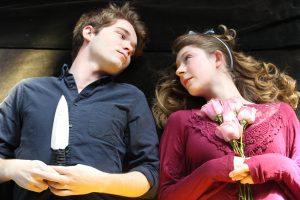By Linnea Barklund
In March 2018, current MFA student Hannah “Rock” Roccisano directed a production of John Ford’s ‘Tis Pity She’s a Whore, starring S&P students Ryan Wilson, Claire Wittman, Danielle A. Festa, Jessie Lillis, Tiffany Waters, and Christian Fernandez. The production team included Heron Kennedy, Kirsten Wimberg, Joshua Richard Williams, Louisa Zachmann, Kaitlin Moore, and Mai Guss. A few weeks after the performance, I sat down to talk with Rock. This is her story [DUN DUN].
***
LB: Could you articulate why this project happened and why ‘Tis Pity specifically?
HR: This project happened because I [auditioned for the] MFA company and in the interview process they asked me what concentration I was interested in and I said directing. And they were very surprised by that. Doreen [Bechtol] mentioned, “Your cohort hasn’t really seen you direct. Have you thought about an independent project?” And I said, “Yeah, I have. ‘Tis Pity.” And she said, “Great, do that.” [I chose] ‘Tis Pity specifically because it would give me some problems to solve.
LB: Can you tell me more about the specific problems you were considering going into the show?
HR: I did not anticipate doing that show in a thrust; I wanted to do it originally in a runway.
LB: The blocking seemed to very much reflect that.
HR: I had to completely alter that the first day. I had a thematic reason for doing [a runway staging]. I wanted the audience to be there with each other, but I could still do that in a thrust. The intimacy [between Annabella and Giovanni] changed. My original idea of the intimacy was much more graphic and I’m kind of mad that I didn’t do it as much as I anticipated.
LB: Honestly, I was a little surprised at how tame this production was.
HR: I wanted a much more graphic thing to happen and I realized that I could have caused trauma.
LB: And was that out of conversation with your actors or self-reflection?
HR: It was out of conversation with intimacy directors. And also it would have been a rape as opposed to a consensual intimate interaction with unexpected violence. The intention would have been different.
LB: Can you talk specifically about [that moment]?
HR: Yes. In conversation with Claire and Ryan [who played Annabella and Giovanni], I originally gave them the idea that I would like this to be a completely consensual relationship with both characters being really active. I wanted to make them active members of this relationship because, again, it does not fit the text that she is a victim, not in this relationship.
LB: I think that’s why it’s such a compelling relationship. It’s in that taboo world, but it’s such a loving, healthy relationship in so many ways.
HR: Giovanni says, “To kill thy fame and kill thee in a kiss.” The violence was not consensual, but the sex was. Meaning the original [staging] was not going to be that, meaning they would have started off consensual and then into a position where she had no control.
LB: Okay, but also she’s being murdered, so ultimately she does lose control. So I guess I’m interested in teasing this out a little bit, like, where the consent of the sex is superseded by the non-consent of the murder.
HR: In my version, he did kill her while they were having sex. However, all of the sex was consensual but not the violence. In the other instance, both the violence and sex would not have been consensual. That’s a very heinous act to do it that way. It brings up a lot of questions of who Giovanni is and is he that malicious? To me, that speaks maliciously.
LB: Speaking of intimacy and violence, you mentioned trauma earlier. First of all, trauma for whom: the actors or the audience?
HR: Audience.
LB: What kind of responsibility do you think theatre makers have as far as that sort of thing, as far as caring for the audience? You put a trigger warning and yet you still let your concerns about what the audience might think dictate, to an extent, what the violence/intimacy was.
HR: It’s a very complicated question.
LB: That’s why I’m asking it.
HR: Thank you. Actors first––in the process first. The text is an inanimate object. The text is something that we can alter. We are real people and the audiences are real people. We have a duty to both. But I think both are important to consider. The danger you get into with the audience question is exactly what I experienced. Did I back out? Could I have pushed this further? I’m never going to know that answer. Or maybe I will.
***
“The people that were involved in this process taught me more than I taught myself.” What struck me the most about this conversation––of which this is just a very little bit––was Rock’s praise for the many people working with her. While her reasons for some of her production choices were unnecessarily vague, her admiration for the team working with her was clear and constant. Since she already knows how to cast well, as an audience member I look forward to seeing what choices––particularly in the realm of violence and intimacy––she will allow herself as a more mature, more confident director in future.



